Algae Guide
Algae in the aquarium is inevitably the greatest nuisance for every tank keeper, be it in a classic social tank, an aquascape, a biotope aquarium or breeding tanks for fish or shrimp. Many aquarium keepers simply abandon and give up this beautiful hobby due to the troubles of algae bloom making their aquarium look unsightly. Many often says that it takes too much time to fight algae and keep the aquarium nice and clean, or might even become very frustrated when the aquarium is full with algae.

The appearance of algae or algae bloom is a sign that there is some kind of biological system imbalance within the tank. During the cycling phase, when the biological system is still finding its stability, a certain algae population is perfectly normal. Diatoms generally form during the first few days to weeks, and after that green algae will form. In the long run, however, it is possible to have an aquarium without visible algae, and this is even realistic for beginning aquarium keepers. Just keep some basic things in mind and inform yourself about the reasons for the formation of algae.
Frequently, the ecological balance has not yet been established in a newly setup tank. You'll need to be patient until the system is balanced. The relation of algae to aquatic plants is not yet balanced in the beginning either. Stronger plant growth will shift it towards the plants, at the detriment of the algae. For this reason it is rather important to start the tank with a good plant population and to use fast-growing stem plants. Until the tank has found its biological balance we recommend controlling the algae with specific measures for each kind. First and foremost, the use of a sufficiently large number of algae eaters is recommendable. The most efficient algivores are Amano shrimp and nerites of the genera Vittina, Neritina and Clithon.
Why will algae form in an aquarium that has been standing for quite a while? In short, the presence of ammonia and light. The more light we have (modern, high-tech aquariums have a lot of light), the less ammonia is needed to trigger algae-bloom. This is why beginning aquascapers see more algae after setting up their aquariums than traditional, low-tech hobbyists.

With gaining some experience or occasionally spending just a little more money on your aquarium equipment such as a bigger capacity filtration system, use of Twinstar Nano+, Chihiros Doctor Mate and etc to support the equilibrium - you will surely be able to maintain an algae-free beautiful aquascape. It is never a good idea to only treat the symptoms, it is not enough to remove the algae (if it can be removed at all), and it is absolutely the worst idea to use algae remover chemicals (biocides). Find the flaws in your system instead.
Point is, we should not fight algae! We should find the CAUSE and we should eliminate that! - quoted from GreenAqua
Ammonia cannot be eliminated entirely unless you make bigger, daily water changes but even so, that will only be a symptom cure. The main goal is to find out what causes the ammonia levels to spike in the water. This is when things becomes more complicated. Ammonia spikes often occurs as a result of decomposing organic elements in your water from multiple sources such as dirty or inefficient filter, fish that died and remained undiscovered, decomposing plant leaves, accumulated mulm, etc.
When this happens in a planted tank, it causes a nutritional imbalance. Algae will find highly favourable conditions, which they will use for visible growth. We have defined "nutrients" as all parameters of the four basic groups comprising the elements light, CO2, micronutrient and macronutrient fertilisation). People used to think that single nutrients like phosphates or nitrates were responsible for algae growth, however, this theory has been proven wrong. These nutrients are crucial for plant growth. If they are deficient, the plants will not grow well and cannot compete against the algae. A nitrate or phosphate deficiency will thus not prevent algae but can actually be the cause for algae growth.
If you have not been using plant fertilizing before and start dosing regularly, you might start to see algae blooming, giving the wrong idea that the whole mess is caused by nutrients. This is simply not true. Algae are just like plants - but on a lower evolution level: they like the nutrients. If you had an aquarium that was full with non-invasive algae and you start fertilizing it properly, algae will also start to thrive - together with your plants. A previously insignificant algae problem caused by another issue will start to be visible.
The solution for the problem is not to stop dosing or starting to cut back on fertilizers. The solution is to eliminate the cause. For example, if the cause was a simple lack of nutrients (with the previous fertilizing method) then you should continue dosing and removing the algae until they just disappear (plants "overgrow" algae). If the original problem was not (only) the lack of proper nutrients than regular dosing and algae removal will not be enough, as part of the original problem still persists. You will have to find the additional causes in this case.
This guide will help you find the different causes for algae appearance and will help you address those causes. Luckily the different types of algae will indicate slightly different causes so you will have a clue where to start looking for the source of trouble.
Types of algae
Brown algae - Diatoms

Low-level lighting in old, non-CO2 aquariums, or high levels of ammonia in newly set-up tanks is thought to be the cause of this algae. It typically like ammonia and silicates. The presence of silicates may originate sand, bad-quality gravel, stones not suitable for aquarium use, zeolite-based filter material and also in tap-water.
If often creates a slimy brown surface or comes as thin brown threads. It is not a "dangerous" algae type and can be easily removed (by just wiping the aquarium glass). Algae eaters as Otocinclus will consume and remove it quickly. In low-tech (non-CO2) aquariums, lighting intensity will need to be increased (now the hours of illumination) - but please keep in mind that increasing the light will result in higher CO2 and fertiliser need. With new high-tech aquariums it will just disappear by itself with time. Manual removal and help the spread of nitryfing bacteria is the best chance of removing it quickly. Appearance in older, properly lit aquariums will show bad water quality and presence of silicates.
Green Spot Algae - GSA
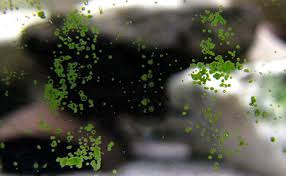
Green Spot Algae commonly known as GSA appear as small, round spots on hard surfaces, most visible on the aquarium glass. It will also appear on slow growing plants, typically the Anubias-types. It is the algae of healthy aquariums and will probably see some of it in all aquariums. It likes strong lighting and blooms when Phosphate and/or CO2 levels are low. It sticks strongly to different surfaces so algae eaters will not really remove it. The Zebra Nerite Snail and it's family will remove some of it.
It can be manually removed from the glass using an Algae Scraper. Badly affected leaves should be trimmed and slow-growing plants that tolerate low lighting shoudl be re-planted in shady areas. With medium-light aquariums you should pay attention to regular water changes and efficient filtration. With strong lighting check the efficiency of your fertilising regime and CO2 injection. As it is mostly caused by Phosphate (PO4) deficiency, start to add more Phosphate to address the main cause.
Green Dust Algae - GDA
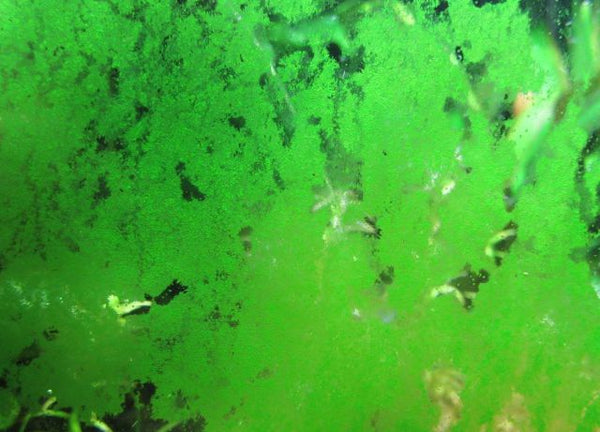
The exact origin of this type of algae is not really known. This algae mostly present in high-tech planted aquariums, more frequently seen in new aquariums. The really small green spots forms a dust-like layer on aquarium glass and hardscape. This type of algae will not usually grow on plants. It is mainly caused by low CO2 levels and low nutrients.
Algae Scraper are not a solution as the cells removed from the glass and floating in the water will stick to hard surfaces again after some time. To treat this issue, these algae will need to be left and grow without disturbance for 10-20 days! It will form a thick green layer that can be removed (sucked out) in big chunks, and if the root cause is addressed, it will not return.
Green Fuzz Algae
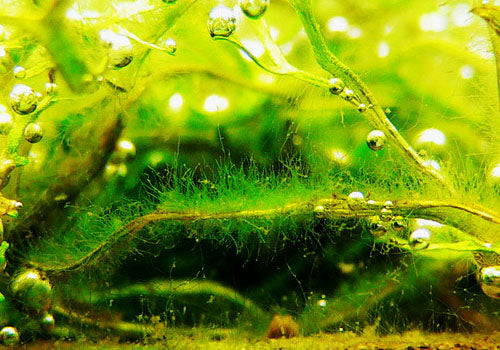
This is a form of thread algae indicating low- or fluctuating CO2 levels! Carbon-dioxide fluctuation can be caused by uneven CO2 levels (because of poor flow or inefficient diffuser) or a timer that was not set up correctly (CO2 levels will have to reach the desired level at the time when light - even natural light in your room - appears). It grows thin threads of just a couple of millimeters on plant leaves. It indicates that the plants are suffering (leaves rotting locally) due to mainly nutrient deficiency (for example the local lack of CO2 that is not distributed in evenly by the flow in the whole aquarium). It can appear on old, and damaged leaves. Algae eaters and Amano Shrimp will eat this type of algae.
This algae can be managed by ensuring proper CO2 levels, and the time of CO2 injection is set according to the lighting period (start 2-3 hours before-, and switch it off together with the lights). It is recommended to take into account natural light too. CO2 need of plants can rise due to a cast of light in the mornings for example - even if lighting has been set to switch on at noon.
Green Beard Algae

The Green Beard Algae is presumably a more virulent form of Green Fuzz Algae. The fine longer threads will attach to plants and hardscape. It can grow a couple of centimeters and form a dense green coat on their surface. It can be very decorative at times. Algae eaters will like it very much.
It can be difficult to remove mechanically, as it attaches strongly to surfaces. the threads are slimy and weak. It is a typical algae of fish tanks without plants, but it does not necessarily indicate bad water quality. In planted tanks it is indicating that the lighting period is too long (reduce it to 8 hours) or CO2 levels are too low, or there is not enough Nitrate in the water.
Black Brush Algae - BBA
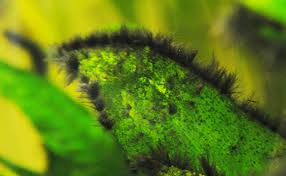
Black Brush Algae or Black Beard Algae (BBA) is a very difficult type to get rid of! The small black, dark-grey or reddish hairballs will grow in clumps or patches of fine black tufts with a length of half a centimeter. It likes places with strong flow, it sticks to hardscape and submersed equipment (filter in- and outflows, internal filters, etc.) If you have hard water, the Calcium will get incorporated into the threads and algae eaters will not like it. The Siamese Algae eater and Amano Shrimp will eat it, but they are not efficient.
In a strongly lit aquarium, it can be caused by the lack or uneven distribution of CO2. With weak lighting it will help to let the water rest before water changes. Tap water (and fresh RO water) are rich in CO2 - this will favor these algae but slow-growing low-tech plants will not profit from it.This is one of the most difficult algae to remove. It appears with no apparent cause even in older, very stable lush tanks. Most of the times the only solution is to remove the spots - one-by-one with heroic scrubbing, and that would not at all guarantee that it is not going to come back. Using a liquid carbon additive or Hydrogen Peroxide (switch the filter off, apply locally with a syringe) will help kill this algae. It will turn red and whitish before disappearing.
Blanket Weed (Cladophora)
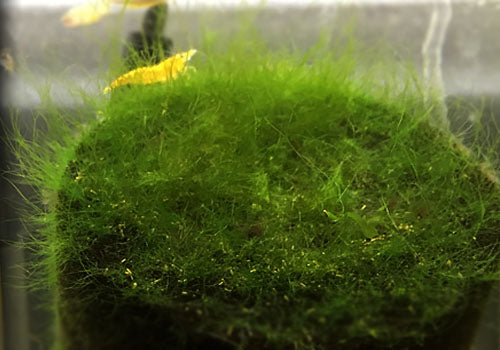
Often the cause of this algae is put down to the moss-ball Cladophora aegagropila (Marimo Ball) for spreading the Cladophora infection. The truth is, that the moss-ball is indeed a type of Cladophora, but it is different from the one that causes the Blanket-Weed invasion. The moss-ball is slow-growing, so it can also be easily attacked by algae, that will thrive on the surface of the ball.
The Blanket Weed is a rough, branching algae that looks a like some kind of moss. It will stick hardly in a point and spread from there, so it can be isolated and removed from the middle of your plants. If it contaminates your moss, you will need to trim it down hard. Algae eaters will avoid it. Improving flow and CO2 will help, weaker lighting will push it back relative to the plants. This algae will not spread in air, so you can completely avoid it if you use only tissue culture plants or emersed plants in your aquarium.
Green Water

Green Water is caused by floating algae. It can be composed of multiple types of organisms, from real green algae like Chlorella to flagellates. It appears very quickly and it is difficult to get rid of it. It is often caused by an Ammonia spike, nutrient-level problems or low CO2. It is generally triggered by some kind of water quality problem - for example the Ammonia released in the water after you disturbed the substrate. Improving water quality (with water changes for example) will not solve the problem. Once the algae have bloomed they will survive even in low-nutrient conditions. You can do a 4-day blackout to solve the problem but bear in mind that the algae that have been killed might cause Ammonia spikes. Always ensure good aeration with blackouts. Using UV filters is also highly efficient against Green Water. The third option is the usage of a diatom filter that will clean these algae from your water in hours and they will not produce any Ammonia that might cause further trouble. Making a diatom filter is easy, just get some Diatomaceous earth (diatomite) and use it temporarily in your filter. There are other chemical solutions that might seem easy to apply but they are far from ideal because they might kill algae but they can be of adverse effects to your sensitive fish or plants.
The cloudy but not green water is caused by floating ciliates (also known as infusoria among aquarists). Some of these tiny creatures will possess chlorophylls so they can use light and thrive in low-nutrient conditions too. You will have to perform a blackout combined with a UV filter treatment and diatom filter. Green Water has its own advantages in the aquarium hobby: you can use that as food for hatching Artemia and Cladoceras (water fleas).
Water Silk (Spirogyra)

This algae forms, long and strong threads with a smooth touch. It is very decorative under microscope, the thread is a green spiral stretching for the whole length. It's appearance indicates a previous Ammonia spike that was caused by a fish carcass or by disturbing the gravel or substrate. Once it is present it is difficult to eliminate because the needs of these algae are very similar to plants. A blackout and liquid carbon or hydrogen peroxide will usually help. Algae eaters do not like it in particular, but will eat it if there is no other algae in the aquarium.
Green Thread Algae
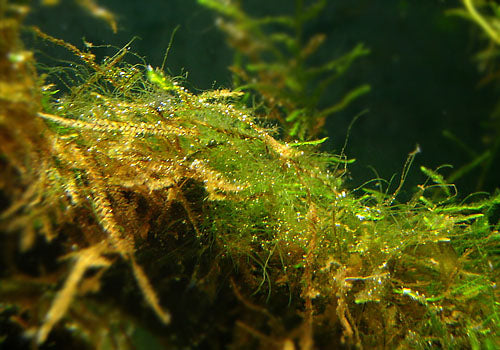
It has long, span-size threads. It can be collected by coiling them on a toothbrush but it is almost impossible to eliminate them from mosses. Some say they appear as a result of excess iron in the water that can be caused by unbalanced plant nutrition or ingredients from root tabs that were somehow dissolved in bigger quantities into the water. It frequently appears together with hair algae. Change big amounts of water and rethink your dosing regime. The Siamese Algae eater and Amano shrimp will eat it.
Hair Algae
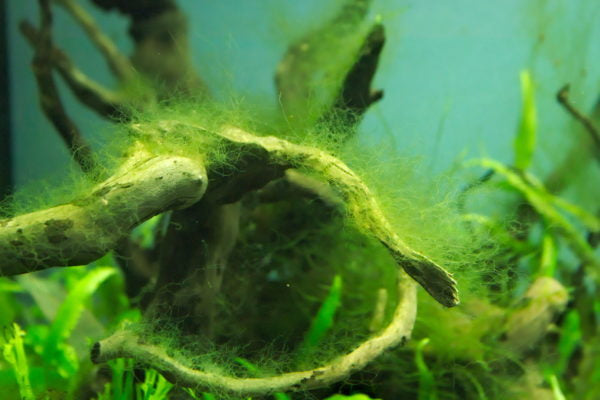
Thin, cotton wool-like greenish-greyish threads stretching for a couple of centimeters. They will not stick to surfaces. It frequently appears with low nutrient-levels. It is also connected to low CO2 levels and low flow. Algae eaters will love it, it is a good complementary food for all herbivore fish. It is advisable to clean the gravel once it appeared. Strong flow will limit its growth.
Staghorn Algae

It forms threads of grey or bluish horn-like branches. It typically appears on leaf edges in the form of fluffs. It likes areas closer to the surface. It sticks hard and the surface is really greasy so it is almost impossible to remove. High Ammonia levels, low-flow and nutrient balance issues will favor the appearance of this algae. Clean the gravel and the filter if it is clogged and the flow is weaker. Cut the infected leaves. Apply liquid carbon additives or hydrogen peroxide with the filter stopped for a couple of minutes - the algae will turn red and die.
Blue Green Algae - BGA (Cyanobacteria)

Caused by low nitrate-levels, ammonia spikes and dirty substrate or filter. Blue-green Algae are in fact photosynthesizing bacteria. There are many types that can appear in the aquarium. Some of them will thrive in high nitrogen-level substrates with decomposing organics, others will appear in completely nitrogen-free environments. Most common are the blue-green-, grey- or black-colored types that will form a plaque on the substrate surface and plants. This plaque can be easily sucked out with a hose during water changes but it will usually reappear if you do not address the cause.
It also frequently appears between the glass and the substrate or plants - at the bottom of the aquarium - along the front glass and sides. Once it appeared it will start to spread quickly and can become dangerous to your ecosystem. The invasion is also characterized by a bad smell around your aquarium. The blue algae can produce toxins that can kill the fish and plants, so their spreading should be stopped quickly.
A blackout will help as a symptom treatment, but if useless, we need to use antibiotics as a last resort. Because we are dealing with bacteria here, the erythromycin antibiotics is effective, but that will also kill the nitrifying bacteria in the substrate and our filter too! This is a drastic measure. If you choose to walk this path, you have to look at your nitrate balance carefully and try to help recolonizing your filter and substrate with filter bacteria additives. If the BGA does not appear to be very invasive, you can try to remove it with regular water changes and by using fast-growing stem plants. If nitrate levels were low in your aquarium, you might want to increase that to 10-30 ppm.
White Fungus
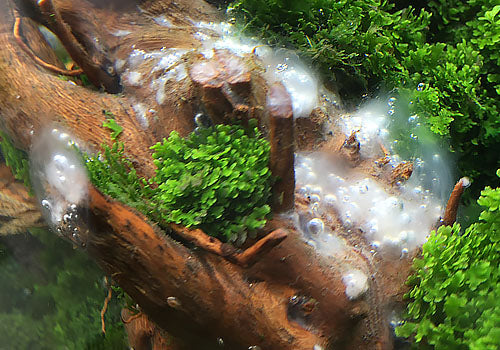
This is a regular guest in new aquariums that have red moor wood in them. It always appears on the wood in the form of white slimy surface - forming spots or continuous mold. It is absolutely harmless and it will disappear by itself after 1 or 2 weeks. The appearance of the fungus is caused by organic material and spores present in this type of wood. It's appearance is inevitable and we just have to wait until it disappears as it will not release harmful substances in the water. Some algae eaters will even eat it. If you do not like the look of it and would not want to wait to disappear, you can brush it off with a toothbrush.
In old tanks, fungus can be found in two places: on fish carcasses and rotting food. Physical removal (sucking out or taking it out with a pinsette) of these will solve the problem.
References
Reference sources from greenaqua.hu and aquasabi.com
